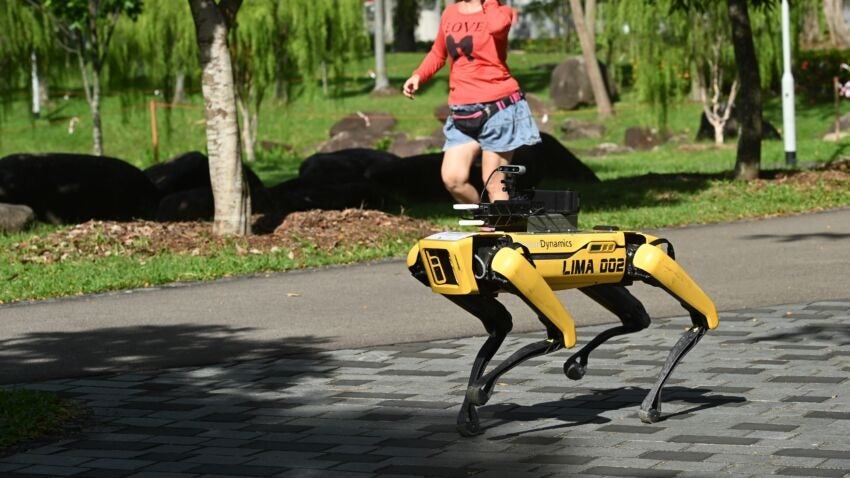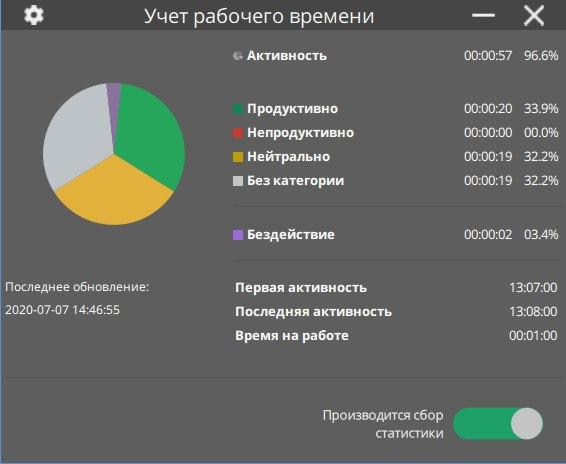Robot Shepherd
In May 2020, a Boston Dynamics robot dog took to the streets of Singapore to monitor the observance of social distancing by meat sacks.

Each robot patrolled its section of Singapore's Bishan-Ang Mo Kyo Park. When meeting with a group of people, the robot voiced a pre-recorded message: “Let's keep Singapore healthy! For your safety and the safety of those around you, please stay at least one meter away. Thank".
The Spot robot dog develops a speed of up to 1.6 m / s, studies the surrounding space through stereo cameras with a total viewing angle of 360 °, weighs 25 kilograms - light, small, and maneuverable. Spot was introduced by the company in 2016 and was offered mainly for use in production, for example, for remote inspection of production facilities.
Spot robots cannot be called completely autonomous - during the test period it was controlled by specialists. However, taking into account the current level of development of computer vision and decision-making systems, it is easy to imagine how the robot dog determines the route and the target on its own - this is quite realizable. Spot is already equipped with cameras that are used to identify groups of people. But the Singapore government has said that robots will not use facial recognition or collect personal data from citizens. It is not known how another owner can dispose of the dog's capabilities, but there is now room for this: from June 16, 2020, the robot dog went on sale (before that it was leased to enterprises).
The pandemic is changing living conditions, but many do not like control, and not everyone willingly obeys the demands to keep their distance and take full precautions. One of the situations that influenced the withdrawal of the robot into the park was a conflict between a passer-by and a park employee related to the need for social distancing. Will pedestrians react more calmly to controls and restrictions if they sound from a yellow robop, speaking in a polite female voice? It all looks pretty dystopian, but so far, it seems, no one has attacked robops.
Robot checking if your hands are washed
Another development that is relevant for the events of 2020: Fujitsu has developed an artificial intelligence-based hand washing control system . Two thousand videos of hand washing with different types of soap and washbasins were used to train the system. The system can recognize complex hand movements and determine if soap is being used. The system verifies that hand washing is consistent with the Japanese Ministry of Health's six-step procedure, which includes hand washing, fingers, finger gaps, wrists, and fingernails.
The company believes that this system can be used to monitor compliance with hygiene rules by employees of the hotel industry, food production, medicine, and so on, but there is no commercial version of the system yet.

The system can determine the cleanliness of hands, but not the identity of people. Although, if you combine it with a facial recognition system, then companies will also be able to monitor who exactly is a mess in the team.
Meanwhile, in Russia, not only face recognition has been combined with hand washing control, but the combination has already been patented and sold as a ready-made solution. The Damate company, which produces milk and meat, uses the Directive system developed in Skolkovo . The developers of the Directive: Sanitation promise to test hand sanitization in accordance with international standards with 100% accuracy. Damat now has 20 handwashing control points, through which 2,250 employees pass and it is plannedto install 21 systems at a plant under construction for deep processing of turkey meat in the Penza region.
The purpose of implementing the system is not to increase profits (on the contrary, the implementation and technical support of the system is not cheap), but to prevent problems when just one pair of unwashed hands can infect consumers, cause financial problems and ruin the reputation.
Electronic traffic policeman
Another example of automated control is artificial intelligence, which writes out fines instead of the traffic police. Since 2018, the Moscow authorities have taken up the development of intelligent traffic control systems. The neural network is used to process millions of photos and automatically detect violations. There are no new principles for detecting violations: the system is simply designed to relieve the technicians of the Traffic Management Center (TsODD), who process photographs from cameras for the traffic police, so that they have more time to study controversial cases and filter out erroneous fines into marriage.
How perfect is such a system and will it issue fines unfairly? It is quite possible, since the result is highly dependent on the input data (photo quality) and on the principles of the machine learning model used in the system. It is more logical to ask the question as follows: will the percentage of errors in artificial intelligence be less or more than the percentage of mistakes of living specialists performing the same task? But we are unlikely to know the answer: fines remain a source of income for the state, regardless of who issued them, and someone at the top is unlikely to calculate a certain percentage of injustice and seek to reduce it. So the fairness of intellectual control in this case depends not only on the technologies used, but also on the goals behind them. It is only known that both real people and programs make mistakes.and incidents ("A fine for a shadow and a bird without numbers: how traffic cameras make mistakes ”) does not only occur in Russia. However, where there is an automated issuance of fines, an automated fight against incorrectly assigned fines can also be introduced: in Dubai, artificial intelligence helps to deal with mistakes that people make when writing out fines, and in Germany there is a so-called digital lawyer .

Robot wife of a car enthusiast
A more humane intelligent control system is smart cruise control. One of the developments in this area belongs to Hyundai : in October 2019, the SCC-ML (Smart Cruise Control + Machine Learning) system was announced. It takes into account the distance to another vehicle, reaction time to changing road conditions and speed. Unlike conventional cruise control systems, the SCC-ML not only maintains the distance to the vehicle in front and the set speed, but is also able to learn from the driver's actions.
In 2019, Nvidia Corporation, active in driver solutions, created a neural network that regulates high beams for the driver. The network reactson vehicles that come into the field of view of the camera, for which the taillight or headlight is on in the current camera frame. There are 2 modes available: in the first mode (Auto High Beam), the high beam lighting system automatically turns on in low light conditions.
Parked cars are considered inactive and ignored, and when active cars are detected, the system automatically switches to low beam or turns off. As soon as active vehicles move outside the camera, the high beam will automatically turn on again. In the second mode (Adaptive Driving Beam), the AI dims the individual LEDs in the headlights, creating glare-free zones.
Such developments are a compromise between fully self-driving and helping the driver, who controls the car independently, but with the help of intelligent control from the system. Just like the already familiar parking sensors, they take some of the functions from the driver in order to facilitate the driving process. For most users, it doesn't matter how exactly these solutions are technically implemented - it is important that they can be relied on.
Robot boss
Automated systems also interfere in the daily work processes of office workers, which are improved and acquire new functions based on data about the psyche. The manufacturer of software for monitoring remote employees, Kickidler, has released the AutoKick function for self-monitoring of employees. "Autokik" consists of two parts: self-control tools in the form of a report and automatic notifications to the employee about his violations (what is considered a violation is configured in advance). That is, on the other hand, the task of Avtokik is to automate kicks handed out by the authorities.

At first glance, a program that monitors everything that you do on your device during working hours is additional control on behalf of the bosses who want you to get the most out of your time. If you look closely, it also acts in the interests of the employees themselves, because productivity cannot be increased where the employee is uncomfortable.
The time has almost passed when it was believed that one should squeeze the maximum out of a person by coercion under slogans like “Get out of the comfort zone! Get the best! Set a goal and go to it, no matter what! "
Many employers already know that to get out of your comfort zone, you first need to enter it.

And what can be understood as comfort for an employee who spends the whole day in intellectual or communicative work in front of the monitor? Let's leave the arguments about the meaningfulness and the degree of interestingness of the work behind the scenes - we hope you enjoy your work. But apart from motivation, there are also psychophysiological limitations.
Some studies show that a person is effective at work for less than three hours a day, and the level of concentration drops dramatically after just 20 minutes. In general, in psychology, it is believed that the duration of effective voluntary attention of an adult is a maximum of 45-50 minutes. After that, you need to switch attention to a different type of task.
In the popular Pomodoro time management technique, 25 minute intervals are considered standard, but they can be adapted for yourself, and the main idea remains the idea of frequent breaks in monotonous activities. "Autokik" just can prompt an employee who works for a long time without interruptions to take a short break in work. This function can be used for health care - a reminder of a break can hint at the need for physical activity: once in several working periods of time, you can do a little exercise or gymnastics for the eyes.

Robot nanny
AI-powered designs can also detect stress levels and help train attention and relaxation skills. For example, the participants of the intensive training for the digital economy and the National Technology Initiative (NTI) Island 10-21 collected data and used the system based on artificial intelligence to adjust the educational process. The main goal is to avoid burnout and efficiency degradation due to stress.
The Zelenograd group of companies "Neurobotics" has released the neuro-headset NeuroPlay for sale, which allows you to measure the electrical activity of the human brain. The user of the headset can adjust the work of the brain in accordance with the selected workout to combat anxiety, insomnia, irritation, impaired attention, stress. To improve, you will have to follow the recommendations issued by the system.
Such developments control the mental and physical state of a person and, by processing the obtained data, help to improve well-being and increase productivity.
A robot watching not to express
In the interests of business, the programs even learned to control the speech of employees: the Anryze service offered the brokerage company Weeden and Co a technology to control the use of certain words by brokers when communicating with clients. The fact is that brokers are prohibited from guaranteeing the yield on the securities being sold. Companies that violate the ban can receive a fine of $ 5 million, as well as an analysis of the incident and reputational risks. The Anryze service catches forbidden words in an employee's speech and analyzes the context in which they were spoken.

If a broker utters words about a guarantee of profitability, then immediately after the conversation he receives information about a possible violation of the law. In general, control is hardly pleasant in itself, but it simply reinforces the already existing limitation on the pronunciation of certain phrases - a kind of cost to the profession.
Voluntarily into the Matrix
The fact remains: people, in their own interests, transfer control over themselves to machines. For business and the state as a whole, there are some advantages, except for the high cost of development, and as for ordinary people, they exchange privacy and independence for receiving recommendations and removing responsibility for making decisions.
In the United States, one can feel the tension between guaranteeing individual rights and protecting collective interests during this health crisis. Thus, GAFAM has at its disposal in the United States information that would be extremely valuable during the crisis: a huge amount of data on the American population. Larry Brilliant, an epidemiologist and CEO of Google.org, argues that this information has the potential to "change the face of public health" and believes that "few things in life are more important than the question of whether core technologies are too powerful, but a pandemic is certain , one of them "(N. Skola, Big Tech faces the trap of the" Big Brother "on the coronavirus, POLITICO, March 18, 2020) Therefore, the US government has asked these companies to provide access to aggregated and anonymous data, especially in relation to mobile phones, to combat the spread of the virus (T. Romm, E. Dvoskin, S. Timberg, US government and the technology industry discuss how to use data on the location of smartphones to combat coronavirus, The Washington Post, March 18, 2020 ). However, these companies are wary of legal risk and potential image damage (S. Overley, White House Seeks Help Fight Coronavirus in Silicon Valley, POLITICO, March 11, 2020.). Data legislation would likely help foster public-private dialogue and determine which types of emergencies should fall under the collective interest in individual rights (and the conditions and guarantees of such a mechanism), but Congress has not achieved any progress over the past two years. progress towards such a law.
I would like to end this review with the words of Yuval Noah Harari from the article "The World After Coronavirus" ( The Financial Times, March 20, 2020 ):
Temporary measures to control and mass monitor the population using this technology should not be considered trivial and should not become permanent.